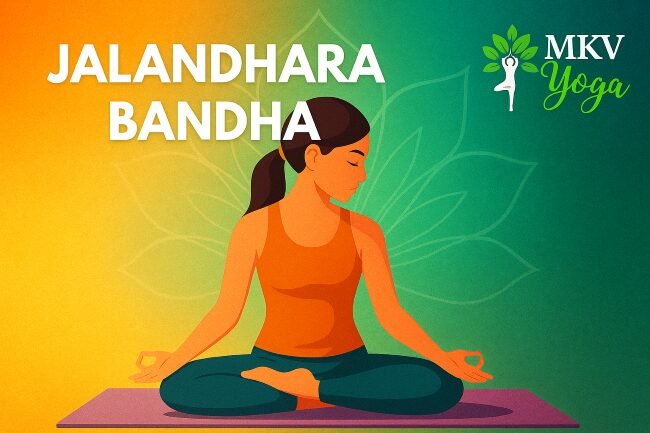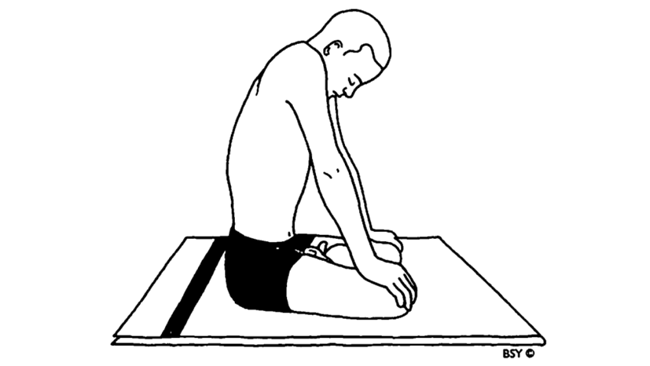Table of Contents
Jalandhara Bandha in Yoga – A Complete Guide
Jalandhara Bandha, also known as the throat lock or chin lock, is one of the three key bandhas (energy locks) in yoga. It is commonly practiced during pranayama (breathing exercises) and meditation to regulate prana (life force) and deepen concentration. The word Jalandhara comes from Sanskrit, where Jala means “net” or “web,” and Dhara means “to hold.” This bandha controls the flow of energy in the throat region and prevents it from leaking upward, ensuring balance in the body and mind.
How to Practice Jalandhara Bandha (Steps)
-
Sit comfortably in a meditative posture (Padmasana, Vajrasana, or Sukhasana).
-
Keep your spine straight and place your hands on your knees.
-
Take a deep breath in and hold the air (internal breath retention – antar kumbhaka).
-
Lower your chin towards your chest, pressing it firmly into the notch between the collarbones.
-
Straighten the arms, lock the elbows, and keep the chest slightly lifted.
-
Maintain the lock as long as comfortable, focusing on the throat chakra.
-
Release by raising the head, exhaling slowly, and relaxing.
Note: Beginners should learn Jalandhara Bandha under the guidance of a yoga teacher.
Benefits of Jalandhara Bandha
-
Energy Regulation – By locking the throat, Jalandhara Bandha prevents prana (vital energy) from moving upward prematurely during pranayama, ensuring proper energy flow in the body.
-
Thyroid and Throat Health – The throat lock gently massages the thyroid and parathyroid glands, helping regulate metabolism and hormonal balance.
-
Calms the Mind – The practice reduces restlessness by activating the parasympathetic nervous system, bringing deep relaxation and focus.
-
Enhances Pranayama – It works with Uddiyana Bandha and Mula Bandha to control prana flow during advanced pranayama practices.
-
Improves Concentration in Meditation – By controlling the upward flow of energy, it helps stabilize the mind, making meditation more effective.
-
Balances Vishuddhi Chakra – Known as the throat chakra, it is associated with communication, expression, and purification. Jalandhara Bandha activates and balances this chakra.
-
Protects the Brain from Pressure Imbalance – While practicing pranayama with breath retention, this bandha protects the brain by regulating blood and energy pressure in the head region.
-
Balances Prana Flow: Controls energy in the throat and head region.
-
Reduces Stress and Anxiety: Calms the nervous system and improves focus.
Precautions and Contraindications
-
Avoid if you have high blood pressure or heart disease.
-
People with cervical spondylitis, neck injury, or throat problems should not practice.
-
Pregnant women should avoid Jalandhara Bandha.
-
Always practice under the guidance of an experienced yoga teacher, especially if you are a beginner.
FAQ – Jalandhara Bandha
Q1. What is Jalandhara Bandha in yoga?
Jalandhara Bandha is the throat lock in yoga that regulates energy flow, balances prana, and activates the Vishuddhi (throat) chakra.
Q2. How is Jalandhara Bandha performed?
It is performed by lowering the chin towards the chest while holding the breath, straightening the arms, and focusing on the throat region.
Q3. What are the benefits of Jalandhara Bandha?
It improves throat and thyroid health, enhances pranayama, reduces stress, balances energy, and supports meditation and spiritual growth.
Q4. Can beginners practice Jalandhara Bandha?
Yes, but only under expert guidance. Beginners should avoid holding the lock for too long and practice slowly.
Q5. Is Jalandhara Bandha safe for everyone?
No. People with high blood pressure, heart disease, or neck injuries should avoid it.
Jalandhara Bandha is more than just a physical throat lock—it is a powerful yogic technique that harmonizes energy, balances glands, and deepens spiritual practices. Whether you are practicing pranayama, meditation, or advanced bandha combinations, this technique ensures that prana flows correctly, protecting the body and mind. With consistent practice under guidance, Jalandhara Bandha can bring inner stability, improved concentration, and a profound sense of calm.
You may also like to read –
Uddiyana Bandha – Steps, Benefits & Precautions for Yogic Mastery


